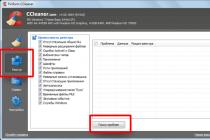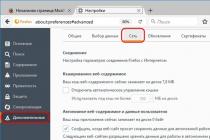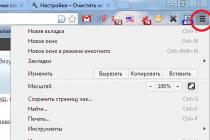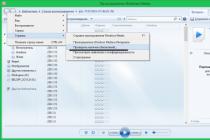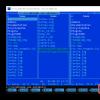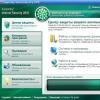practical course
What it is?
At one time (1991-1992), choosing a language Si as the main programming language for math classes, the author was faced with the problem of the lack of normal textbooks that could be recommended to schoolchildren. This forced him to write his lecture notes, which could be called "Practical course of programming on Si» - it includes the information that the author really needed in practice. Years of teaching experience has shown that the synopsis is really in demand and is widely used by both schoolchildren and graduates.
A free open source Dev-C ++ wrapper that includes the GCC compiler is used as a development environment.
The author would be grateful for feedback and constructive criticism regarding the content and design of these materials. If you notice an error or you have suggestions, comments, complaints, requests and statements, write.
License agreement
- 1) publication of materials in any form, including posting materials on other websites;
- 2) distribution of incomplete or modified materials;
- 3) inclusion of materials in collections on any media;
- 4) obtaining commercial benefits from the sale or other use of materials.
By downloading the material, you signify that you have accepted the terms of this license agreement.
Download
Abstract is distributed freely in the format PDF... Requires free Acrobat Reader viewer to view. The course outline is conventionally divided into 4 parts:
- Introduction to C Programming (860 Kb) 29.03.2014
Studying the basic structures of the language and techniques for writing programs. - Data storage and processing (792 Kb) 21.11.2013
C language: arrays, matrices, structures, character strings, structures, recursion. - Development of programs in the C language (937 Kb) 01.03.2014
Program design techniques, structured programming, integer algorithms, numerical methods, modeling. - Dynamic data structures in C (666 Kb) 11.06.2009
Lists, stacks, trees, graphs.
Presentations
Teachers and students can benefit from presentations based on this outline. They can be downloaded from the Presentations page.
Methodology
The main task is to acquaint students with the basic constructions of the language Si: loops, conditional operators, procedures. The study of the sections related to graphics and animation is very successful.
To work with graphics through a browser, you can use Anton Denikin's online service.
8th grade
The program includes the following sections (part of the abstract is indicated in brackets): Arrays (II), Working with files (II), Character strings (II), Rotating objects (III), Modeling (III)... Particular attention is paid to the study of algorithms for working with arrays, including search, sorting, etc. The concept of the efficiency of computational methods is given.
Grade 9
The focus is on learning software development methods in the language Si... Students complete an individual task, during which they learn to draw graphs on the screen, get acquainted with the transformations of coordinate systems, study methods for solving equations, get acquainted with numerical methods, learn to correctly design programs (sections 1-2 of part III). One of the tasks is devoted to the use of Monte Carlo method to calculate the area of a complex figure. New sections also study Matrices (II), Arrays of character strings (II)... The concept is introduced pointers and the simplest operations with them are studied.
Grade 10
Language learning Si goes to a more serious level. Main themes - Memory Management (II), Recursion (II), Structures (II)... It is planned to study the Pascal language as a second programming language. From this moment on, algorithms in theoretical classes are written alternately in two languages.
Grade 11
It is not so much the features of languages that are studied as algorithms. The main sections are - Numerical Methods (III), Modeling (III), Dynamic Data Structures (IV).
The C programming language (pronounced "si") can be described as universal, economical, with a full set of operators, with a modern and flow of control. This language cannot be called a "big" language, nor does it claim to be a "high-level language", it was not created for any specific tasks, on the contrary, they tried to make it as effective as possible for any application. This interesting fusion of ideas put into the C programming language has made it very convenient and more efficient for a wide range of problems than other, perhaps even more advanced, languages.
The connection of "C" with OS "UNIX" is very close, since this language developed along with "UNIX" and most of the software for this system is written in it. At the same time, C is sometimes called a language because it is believed that it is convenient to create operating systems with its help, in fact, database processing programs and games are written with the same success.
C is a low-level programming language, but you should not think that this is bad, in fact, it simply operates with the same objects that any computers constantly work with, with symbols, addresses and numbers. In this case, all objects are combined, compared or subtracted using the usual logical and arithmetic operations familiar to computers.
Although functions for working with composite objects are becoming the norm in the coding world and are embedded in all modern programming languages, C, unlike others, does not know how to work with objects such as a string, list, array, or set. It has no analogue of PL / 1 operations on integer strings and arrays.
C works with memory using the stack and statistical definition, C has no other possibilities of manipulating memory, you will not find a "heap" (Heap) or "garbage collection" in it, as Pascal or Algol 68 can do.
And even the most basic mechanisms, input / output, the C language does not provide, you will not find Read and Write operators in it, there are also no built-in functions for working with the file system. Such high-level operations are provided using link libraries.
Also, the C programming language will refuse to work if you need multiprogramming, synchronization, parallel operations, etc. It contains opportunities exclusively for simple and consistent work, its elements: loops, checks, grouping and subroutines.
Someone may be surprised by such a parsimony of tools provided to programmers ("why should I call a function every time I need to compare a couple of lines!" get a real speed advantage.
On the other hand, a small number of operators reduces the time it takes to memorize them, and you only need a few pages to describe them all. And as practice shows, a compiler with "C" is a compact tool that is quite easy to write. Using modern tools, a compiler for a completely new computer will be ready in just a couple of months, despite the fact that 80% of its code will be similar to the code of previous versions. Due to this feature, the C programming language is considered to be very mobile. And its efficiency is such that it simply does not make sense to write any programs in assembler that are critical to performance, as was the case before. The best example of this is the "UNIX" OS itself, which is 90% written in "C" and for it, almost completely created by numerous programmers in the same wonderful language, which is currently considered the number one programming language in the world.
These tutorials are for everyone, whether you are new to programming or have extensive programming experience in other languages! This material is for those who want to learn the C / C ++ languages from its very foundations to the most complex structures.
C ++ is a programming language, knowledge of this programming language will allow you to control your computer at the highest level. Ideally, you can make the computer do whatever you want. Our site will help you in mastering the C ++ programming language.
Installation / IDE
The very first thing you should do before you start learning C ++ is to make sure you have an IDE - an integrated development environment (the program in which you will be programming). If you don't have an IDE, then this is the place for you. Once you've decided on an IDE, install it and practice creating simple projects.
Introduction to the C ++ language
C ++ is a set of commands that tell the computer what to do. This set of commands is usually called source code or just code. Commands are either "functions" or "keywords". Keywords (C / C ++ reserved words) are the basic building blocks of the language. Functions are complex building blocks because they are written in terms of simpler functions - you will see this in our very first program, which is shown below. This structure of functions resembles the content of a book. The table of contents can show the chapters of the book, each chapter in the book can have its own table of contents, consisting of paragraphs, each paragraph can have its own sub-paragraphs. Although C ++ provides many common functions and reserved words that you can use, there is still a need to write your own functions.
Where does the program begin? Each program in C ++ has one function, it is called the main or main-function, the execution of the program begins with this function. From the main function, you can also call any other functions, it doesn't matter if they are written by us, or, as mentioned earlier, are provided by the compiler.
So how do you access these Standard Features? To access the standard functions that come with the compiler, you need to include the header file using the preprocessor directive - #include. Why is it effective? Let's take a look at an example of a working program:
#include
Let's consider in detail the elements of the program. #include is a preprocessor directive that tells the compiler to put the code from the iostream header file into our program before creating the executable. By connecting the header file to the program, you get access to many different functions that you can use in your program. For example, the cout operator requires an iostream. The line using namespace std; tells the compiler to use a group of functions that are part of the std standard library. This line also allows the program to use statements such as cout. The semicolon is part of the C ++ syntax. It tells the compiler that this is the end of the command. You will see later that semicolons are used to complete most commands in C ++.
The next important line of the program is int main (). This line tells the compiler that there is a function named main and that the function returns an integer of type int. The curly braces (and) signal the start (and end) of a function. Curly braces are used in other blocks of code, but they always mean the same thing - the beginning and end of the block, respectively.
In C ++, the cout object is used to display text (pronounced C out). He uses symbols<< , известные как «оператор сдвига», чтобы указать, что отправляется к выводу на экран. Результатом вызова функции cout << является отображение текста на экране. Последовательность \n фактически рассматривается как единый символ, который обозначает новую строку (мы поговорим об этом позже более подробно). Символ \n перемещает курсор на экране на следующую строку. Опять же, обратите внимание на точку с запятой, её добавляют в конец, после каждого оператора С++.
The next command is cin.get (). This is another function call that reads data from an input data stream and waits for the ENTER key to be pressed. This command keeps the console window from closing until the ENTER key is pressed. This gives you time to see the output of the program.
Upon reaching the end of the main function (closing curly brace), our program will return 0 for the operating system. This return value is important because, by analyzing it, the OS can judge whether our program completed successfully or not. A return value of 0 means success and is returned automatically (but only for the int data type, other functions require a manual return), but if we wanted to return something else, for example 1, we would have to do it manually.
#include
To consolidate the material, type the program code in your IDE and run it. After the program has started and you see the result, experiment a little with the cout statement. This will help you get used to the language.
Be sure to comment on your programs!
Add comments to the code to make it clearer not only for yourself but also for others. The compiler ignores comments when executing code, which allows any number of comments to be used to describe the actual code. To create a comment, use either //, which tells the compiler that the rest of the line is a comment, or / * and then * /. When you learn to program, it is useful to be able to comment on certain sections of the code in order to see how the result of the program's work changes. You can read about the commenting technique in detail.
What to do with all these types of variables?
It can sometimes be confusing to have multiple types of variables when it seems that some types of variables are redundant. It is very important to use the correct variable type, as some variables require more memory than others. In addition, because of the way they are stored in memory, floating point numbers, the float and double data types are "imprecise" and should not be used when an exact integer value needs to be stored.
Declaring Variables in C ++
To declare a variable, use the syntax type<имя>; ... Here are some examples of variable declarations:
Int num; char character; float num_float;
It is permissible to declare several variables of the same type on one line; for this, each of them must be separated by a comma.
Int x, y, z, d;
If you've looked closely, you may have seen that a variable declaration is always followed by a semicolon. More details about the convention - "about naming variables", you can.
Common mistakes when declaring variables in C ++
If you try to use a variable that you have not declared, your program will not compile and you will receive an error message. In C ++, all language keywords, all functions, and all variables are case sensitive.
Using Variables
So now you know how to declare a variable. Here's a sample program that demonstrates the use of a variable:
#include
Let's take a look at this program and examine its code, line by line. The int keyword says that number is an integer. The cin >> function reads the value into number, the user must press enter after the entered number. cin.ignore () is a function that reads a character and ignores it. We organized our input into the program, after entering a number, we press the ENTER key, which is also passed to the input stream. We don't need this, so we discard it. Keep in mind that the variable was declared of an integer type, if the user tries to enter a decimal number, it will be truncated (that is, the decimal part of the number will be ignored). Try to enter a decimal number or a sequence of characters, when you run the sample program, the answer will depend on the input value.
Note that quotes are not used when printing from a variable. The absence of quotes tells the compiler that there is a variable, and therefore that the program should check the value of the variable in order to replace the name of the variable with its value at runtime. Multiple shift operators on the same line are fine and the output will be done in the same order. You must separate string literals (quoted strings) and variables, giving each a different shift operator<< . Попытка поставить две переменные вместе с одним оператором сдвига << выдаст сообщение об ошибке . Не забудьте поставить точку с запятой. Если вы забыли про точку с запятой, компилятор выдаст вам сообщение об ошибке при попытке скомпилировать программу.
Changing and comparing values
Of course, no matter what data type you are using, variables are of little interest without the ability to change their value. The following are some of the operators used in conjunction with variables:
- * multiplication,
- - subtraction,
- + addition,
- / division,
- = assignment,
- == equality,
- > more,
- < меньше.
- ! = unequal
- > = greater than or equal
- <= меньше или равно
Operators that perform mathematical functions must be used to the right of the assignment sign, in order to assign the result to a variable on the left.
Here are some examples:
A = 4 * 6; // use line comment and semicolon, a equals 24 a = a + 5; // equal to the sum of the original value and five a == 5 // five is not assigned, a check is performed whether it is 5 or not
You will often use == in constructs such as conditionals and loops.
A< 5 // Проверка, a менее пяти? a >5 // Check if a is greater than five? a == 5 // Check if a is five? a! = 5 // Check, but not equal to five? a> = 5 // Check if a is greater than or equal to five? a<= 5 // Проверка, a меньше или равно пяти?
These examples are not very clear about the use of comparison signs, but when we start to study the selection operators, you will understand why this is necessary.
C ++ programming language
Last updated: 08/28/2017
The C ++ programming language is a high-level, statically typed, general-purpose compiled programming language that is suitable for building a wide variety of applications. Today C ++ is one of the most popular and widespread languages.
It has its roots in the C language, which was developed in 1969-1973 at Bell Labs by programmer Dennis Ritchie. In the early 1980s, Danish programmer Bjarne Stroustrup, who was at Bell Labs at the time, developed C ++ as an extension to the C language. In fact, in the beginning, C ++ simply supplemented the C language with some object-oriented programming capabilities. And so Stroustrup himself initially referred to it as "C with classes".
Subsequently, the new language began to gain popularity. New features were added to it that made it not just an addition to C, but a completely new programming language. As a result, "C with Classes" was renamed C ++. And from then on, both languages began to develop independently of each other.
C ++ is a powerful language, inheriting rich memory capabilities from C. Therefore, C ++ often finds its application in system programming, in particular, when creating operating systems, drivers, various utilities, antiviruses, etc. By the way, Windows is mostly written in C ++. But the use of this language is not limited only to system programming. C ++ can be used in programs of any level where speed and performance are important. It is often used to create graphical applications, various application programs. It is also especially often used to create games with rich rich visualization. In addition, the mobile direction has been gaining momentum lately, where C ++ has also found its application. And even in web development, it is also possible to use C ++ to create web applications or some kind of helper services that serve web applications. In general, C ++ is a widely used language in which you can create almost any kind of program.
C ++ is a compiled language, which means that the compiler translates C ++ source code into an executable file that contains a set of machine instructions. But different platforms have their own characteristics, so the compiled programs cannot be simply transferred from one platform to another and run there. However, at the level of the source code, C ++ programs are mostly portable, unless some functions specific to the current OS are used. And the presence of compilers, libraries and development tools for almost all common platforms allows you to compile the same C ++ source code into applications for these platforms.
Unlike C, C ++ allows you to write applications in an object-oriented style, representing a program as a collection of interacting classes and objects. This makes it easy to build large applications.
The main stages of development
In 1979-80, Bjarne Stroustrup developed an extension to the C language - "C with classes". In 1983 the language was renamed C ++.
In 1985, the first commercial version of the C ++ language was released, as well as the first edition of the book "The C ++ Programming Language", which presented the first description of this language in the absence of an official standard.
In 1989, a new version of the C ++ 2.0 language was released, which included a number of new features. After that, the language developed relatively slowly until 2011. But at the same time, in 1998, the first attempt was made to standardize the language by the ISO (International Organization for Standartization). The first standard was named ISO / IEC 14882: 1998, or C ++ 98 for short. Later, in 2003, a new version of the C ++ 03 standard was published.
In 2011, the new C ++ 11 standard was published, which contained many additions and enriched the C ++ language with a large number of new functionalities. After that, in 2014, a small addition to the standard was released, also known as C ++ 14. And another key release of the language is slated for 2017.
Compilers and development environments
To develop C ++ programs, you need a compiler - it translates the C ++ source code into an executable file, which you can then run. But at the moment there are many different compilers. They can differ in various aspects, in particular, in the implementation of standards. A basic list of compilers for C ++ can be found on Wikipedia. It is recommended for development to choose those compilers that develop and implement all the latest standards. Thus, throughout the tutorial, the free g ++ compiler developed by the GNU project will be used primarily.
You can also use IDEs such as Visual Studio, Netbeans, Eclipse, Qt, etc. to create programs.
C programming language developed by Dennis Ritchie in the early 1970s to create the UNIX operating system. C remains the most widely used language for writing system software, and C is also used for writing applications. Programming for beginners.
Peculiarities
The C programming language has the following main features:
- Focusing on the procedural programming paradigm, with facilities for structured programming, is a good plus to learn. C.
- Access to the hardware layer through the use of pointers to indicate a location in memory.
- Parameters are always passed to a function by value, not by reference.
- Scope of lexical variables (but closures or functions defined inside other functions are not supported.)
- A standard set of library programs that provide capabilities that are useful but not strictly necessary.
- Using the language preprocessor, the C preprocessor, for tasks such as defining macros and including multiple source code files.
- "O" performance for all operators
The functionality of the C programming language is guaranteed by ANS / ISO C99 C89 / 90 and regulations that explicitly state when the compiler (or environment) issues diagnostics. Programming for Dummies. The docs also indicate what behavior can be expected from code written in the C programming language that conforms to the standard.
For example, the following code, according to the standard, produces undefined behavior.
#include #include int main (void) (char * s = "Hello World! \\ n"; strcpy (s, s + 1); / * probably the programmer wanted to remove the first character from the string S = S +1, * / return 0;)
Note: the style of indentation in the program code varies depending on the preferences of the programmers. See indentation style for more details in the programming basics section.
"Undefined behavior" means that as a result the program can do everything, including work as the programmer intended, or throwing fatal errors every time it starts, or causing single crashes only every time the forty-second program starts, or calls crash when the computer restarts, etc., ad infinitum.
Some compilers do not adhere to any of the standards in the default mode, which results in many programs being written that will only compile with a specific version of the compiler and on a specific platform (Windows, Linux, or Mac).
Any program written only in the standard C programming language will compile unmodified on any platform that has a corresponding C compiler implementation.
Although C is commonly referred to as a high-level language, it is only a "high-level" language when compared to assembly, but at a significantly lower level than most other programming languages. But unlike most, it gives the programmer the ability to completely control the contents of the computer's memory. C does not provide tools for array bounds checking or automatic garbage collection.
The Memory Management Guide provides the programmer with greater freedom to tune the performance of the program, which is especially important for programs such as device drivers. However, it also makes it easy to accidentally generate code with errors resulting from erroneous memory operations such as buffer overflows. Several tools have been created to help programmers avoid these errors, including libraries for performing array bounds checking and garbage collection, and source code checking libraries. The deliberate use of programs written in C from scratch that contain a buffer overflow mechanism is very common in many computer viruses and is very popular among hackers who develop computer worms.
Some of the identified deficiencies in C have been addressed and addressed in new programming languages derived from C. The Cyclone programming language has features to protect against erroneous memory operations. C ++ and Objective C provides constructs designed to facilitate object-oriented programming. Java and C # added object-oriented programming constructs as well as higher levels of abstraction such as automatic memory management.
History
The initial development of C occurred between 1969 and 1973 (according to Ritchie, the most turbulent period in 1972). It was called "C" because many of its features were derived from a predecessor to the language called B, which itself was named Bon after Bonnie's wife Ken Thompson.
By 1973, the C programming language had become powerful enough that most of the kernel from the Unix operating system was rewritten to C, for comparison, the Multics operating system is implemented in the A language, the Tripos OS (implemented in the BCPL language. In 1978, Ritchie and Brian Kernighan published the "C programming language" (the so-called "white paper", or K & R.) for many years , this book served as a specification for the language, and even today, this edition is very popular as a guide and textbook.
C has become very popular outside Bell Labs since the 1980s, and was for a time the dominant language in microcomputer programming systems and applications. By far the most commonly used system programming languages, and is one of the most commonly used computer programming languages for science education.
In the late 1980s, Bjarne Stroustrup and others at Bell Labs worked to add object-oriented constructs to C. "and" C "must be" D "or" P "). Currently, C ++ is most commonly used for commercial applications for the Microsoft Windows operating system, although C remains very popular in the Unix world.
Versions C
K & R C. (Kernighan and Ritchie C.)
C has evolved continuously since its inception at Bell Labs. In 1978, the first edition of Kernighan and Ritchie's "The C Programming Language" was published. He introduced the following features for existing C versions:
- structure data type
- long int data type
- unsigned int data type
- The = + operator was changed to + =, and so on (since the = + operator constantly caused lexical analyzer errors in C).
For several years, the first edition of The C Programming Language was widely used as a de facto language specification. The C version described in this book is commonly referred to as "K & R C" (The second edition covers the ANSI C standard, described below.)
K & RC is often considered the core part of the language that is required for the C compiler. Since not all compilers currently in use have been updated to fully support ANSI C, and reasonably well written K & RC code is also correct in terms of the ANSI standard. C. Therefore, K & RC is considered the lowest common denominator that programmers should adhere to in order to achieve maximum portability. For example, the bootstrap version of the GCC compiler, xgcc, is written in K&R C. This is because many of the platforms supported by GCC did not have a proper ANSI C GCC compiler, so only one basic K&R C implementation was written. ...
However, ANSI C is now supported by almost all commonly used compilers. Most C code from scratch is currently written only to take advantage of language features that are outside the scope of the original K&R specification.
ANSI C and ISO C
In 1989, C was first formally standardized by ANSI in ANSI X3.159-1989 "The C Programming Language". One of the goals of ANSI C was to create an extended K&R C. However, the standards committee also included several new features that introduced many innovations than is usually done in programming when standardizing the language.
Some of the new features were "unofficially" added to the language after the K&R publication, but before the ANSI C process began. These include:
- void functions
- functions returning struct or union data types
- void * data type
- const qualifier to make the object read-only
- struct field names into a separate namespace for each struct type
- memory allocation for struct data types stdio libraries and some other standard library functions became available in most implementations (this already existed, well, at least one implementation at the time of the creation of K & R C, but in fact it was not a standard, and therefore was not documented in the book )
- stddef.h header file and a number of other standard header files.
Several functions were added to C during the ANSI standardization process, most notably function prototypes (borrowed from C ++). ANSI C also established a standard set of library functions.
The ANSI C programming language, with minor modifications, has been adopted as an ISO standard with the ISO 9899 norm number. The first ISO edition of this document was published in 1990 (ISO 9899: 1990).
C 99
Following the ANSI standardization process, the C language specification has remained relatively unchanged for some time, while C ++ continues to evolve. (Actually, Normative Amendment 1 created a new version of C in 1995, but this version is rarely recognized.) However, the standards were revised in the late 1990s, leading to the creation of ISO 9899: 1999, which was published in 1999 year. This standard is commonly referred to as "C99". It was adopted as an ANSI standard in March 2000.
New features added in C99 include:
- built-in functions
- freeing the constraint on the location of variable declarations (according to C ++)
- In addition to several new data types, including long long int (to alleviate the problems associated with the migration from 32-bit to 64-bit processors, looming on many old programs, which predicted obsolescence of the x86 architecture), an explicit boolean data type, and a type representing complex numbers
- variable length arrays
- Official support for comments starting with "/ /" as in C ++ (which is already supported by many C89 compilers as a non-ANSI extension)
- several new library functions including snprintf
- several new header files, including stdint.h
Interest in supporting the new C99 features is mixed. Although GCC and several commercial compilers support most of the new C99 features, the compilers made by Microsoft and Borland do not, and the two companies do not seem to be interested in adding such support.
The "Hello, World!" in C language
The following simple application prints "Hello, World" to standard output (usually a screen, but it could be a file or some other hardware device). A change to this program first appeared in K&R.
#include
Usually, text that is not a program but serves as a hint for the programmer is written in the form of a comment. // single line or / * multi line * /
Anatomy of a C Program
A C program consists of functions and variables. C functions like Fortran subroutines and functions or Pascal procedures and functions. The peculiarity of the main function is that the program starts execution from the main function. This means that every C program must have a main function.
The main function usually calls other functions that help do its job, like printf in the example above. The programmer can write some of these functions, while others can be called from the library. In the above example, return 0 gives the return value for the main functions. This indicates the successful execution of the program to invoke the shell of the program.
A C function consists of a return type, a name, a parameter list (or void in parentheses, if there are none), and a function body. The body function syntax is equivalent to a compound statement.
Control Structures
Compound Operators
Composite operators in C are of the form
{ }
and are used as the body of a function and in places where multiple actions are expected in one block.
Declaration operator
View assertion
;
is a declaration expression. If there is no expression, then such a statement is called an empty operator.
Selection operator
C has three types of select statement: two kinds of if and switch statement.
Two kinds of if,
if ()
{
}
or
if ()
{
}
else
{
}
In an if declaration, if the expression in parentheses is nonzero or true, then control is transferred to the operator following the if. If else is present in the clause, then the control will go to the next set of actions after the else, if the expression in brackets is zero or false.
The switch control statement - in this case, it is necessary to enumerate several values that the variable can take as a selection variable, which must be of an integer type. For each value of the selection-variable, several actions can be performed, which are selected. Each activity branch can be marked with a case label, which looks like the case keyword, followed by a constant expression, followed by a colon (:). None of the values associated with switch constants can have the same meaning. There can also be at most one default label associated with a swith; control is transferred to the default label if none of the constant values match the selection variable that appears in parentheses after the switch. In the example below, if there is a match between the selection variable and the constant, then the set of actions following the colon will be performed
Switch () (case: printf (); break; case: printf (); break; default:)
Repetitions (Loops)
C has three forms of loop operators:
Do () while (); while () () for (;;) ()
In while and do statements, the body is executed repeatedly as long as the value of the expression remains nonzero or true. For while, the condition is checked every time before the start of execution; for do, the condition check occurs after the loop body is executed.
If all three expressions are present in the for statement
For (e1; e2; e3) s;
then this is equivalent to the same as
E1; while (e2) (s; e3;)
Any of the three expressions in the for loop statement can be omitted. The absence of the second expression makes the while condition always nonzero, creating an infinite loop.
Jump operators
Unconditional jump operator. There are four types of jump statements in C: goto, continue, break, and return.
goto statement looks like this:
goto<метка>;
The identifier must point to a label located in the current function. Control is transferred to the marked operator.
The continue statement can appear only within the repetition of the loop and forces you to skip the remaining steps at the current location and go to the next step in the loop. That is, in each of the statements
While (expression) (/ * ... * / continue;) do (/ * ... * / continue;) while (expression); for (optional-expr; optexp2; optexp3) (/ * ... * / continue;)
The break statement is used to break out of a for, while, do, or switch loop. Control is transferred to the operator following the one in which the action was interrupted.
The function returns to the place from which the value was called using the return statement. Return is followed by an expression whose value is returned to the place it was called from. If the function does not contain a return statement, then it is equivalent to return without an expression. In any case, the return value is undefined.
Order of application of operators in C89
- () ->. + + - (CAST) Postfix operators
- + + - * & ~! + - SizeOf unary operators
- * /% Multiplicative operators
- + - Additive Operators
- << >> Shift Operators
- < <= >> = Relational Operators
- =! == Equality Operators
- & Bitwise and
- ^ Bitwise exclusive OR
- | Bitwise inclusive, or
- & & Logical and
- | | Logical or
- ?: Conditional operator
- = += -= *= /= %= <<= >>=
- & = | = ^ Assignment Operators =
- , Comma operator
Data declaration
Elementary data types
Values in
Arrays
If a variable is declared using together with the square brackets (), then it is considered that an array is declared. Strings are arrays of characters. They are terminated with a null character (represented in C as "\ 0", a null character).
Examples:
int myvector;
char mystring;
float mymatrix = (2.0, 10.0, 20.0, 123.0, 1.0, 1.0)
char lexicon; / * 10,000 lines, each of which can contain a maximum of 300 characters. * /
int a;
The last example creates an array of arrays, but can be thought of as a multidimensional array for most tasks. To access 12 int values of the array "a", you can use the following call:
| a | a | a | a |
| a | a | a | a |
| a | a | a | a |
Pointers
If a variable is preceded by an asterisk (*) in its declaration, then it becomes a pointer.
Examples:
int * pi; / * pointer to integer * /
int * api; / * array of pointers of integer type * /
char ** argv; pointer to pointer to char * /
The value in the address is stored in a pointer variable and can be accessed in the program by calling a pointer variable with an asterisk. For example, if the first statement is in the above example, * pi is an int. This is called "dereferencing" a pointer.
Another operator, & (ampersand), called operator-address, returns the address of a variable, array, or function. So in view of the above
int i, * pi; / * declare an integer and a pointer to an integer * /
pi =
I and * pi can be used interchangeably (at least until pi is set to something else).
Strings
To work with strings, you don't need to include the library, because in the standard library C, there are already functions for treating strings and data blocks as if they were char arrays.
The most important string functions are:
- strcat (dest, source) - appends the string source to the end of the string dest
- strchr (s, c) - finds the first queue of character c in string s and returns a pointer to it or a null pointer if c is not found
- strcmp (a, b) - compares strings and a b (lexical ordering); returns negative if less than a b, 0 if equal, positive if greater.
- strcpy (dest, source) - copies the string source to string dest
- strlen (st) - Returns the length of string st
- strncat (dest, source, n) - adds a maximum of n characters from source to the end of dest; characters after the null character are not copied.
- strncmp (a, b, n) - compares maximum n characters from string and a b (lexical ordering); returns negative if less than a b, 0 if equal, positive if greater.
- strncpy (dest, source, n) - copies up to n characters from source to dest
- strrchr (s, c) - Finds the last instance of character c in string s and returns a pointer to it or a null pointer if c is not found
Less important string functions:
- strcoll (s1, s2) - compare two strings according to the locale of the ordered sequence
- strcspn (s1, s2) - Returns the index of the first character in s1, which matches any character in s2
- strerror (err) - Returns a string with an error message corresponding to the code in err
- strpbrk (s1, s2) - returns a pointer to the first character in s1, which matches any character in s2, or null if not found
- strspn (s1, s2) - Returns the index of the first character in s1 that matches a non-character in s2
- strstr (st, subst) - returns a pointer to the first occurrence of the string subst in st or a null pointer if no such substring exists.
- strtok (s1, s2) - Returns a pointer to a marker at s1 separated by characters at s2.
- strxfrm (s1, s2, n) - converts s2 to s1 using the rules locale
I / O File In the C programming language, input and output is done through a group of functions in the standard library. In ANSI / ISO C, those functions that are defined in
Three standard I / O streams
stdin standard input
stdout standard output
stderr standard error
These streams are automatically opened and closed by the runtime; they do not need to be opened explicitly.
The following example shows how a typical letter filtering program is structured:
// Header files, for example, #include Passing arguments to the command line C libraries
Parameters presented on the command line are passed to the C program with two predefined variables - the number of command line arguments is stored in the argc variable, and individual arguments as character arrays are stored in a pointer to the argv array. So running their command line program as
Myprog p1 p2 p3
will give results similar to (note: there is no guarantee that individual lines are contiguous):
Individual parameter values can be accessed using argv, argv, or argv.
Many features of the C language are provided by the C standard library. The "hosted" implementation provides all the C libraries (Most implementations are hosted, but some are not intended to be used with the operating system). Access to the library is achieved, among other things, by standard headers through the #include preprocessor directive. See ANSI C Standard Libraries, GCC (GNU C Compiler).


